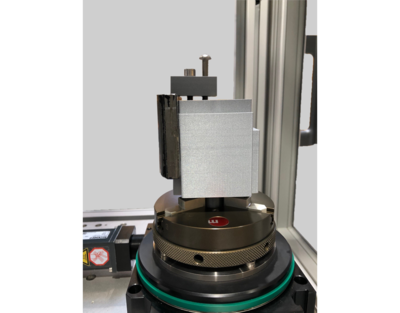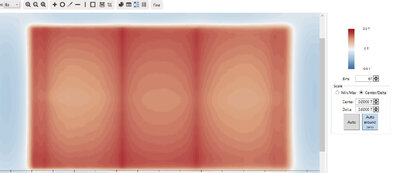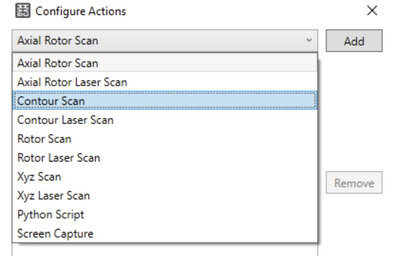Magnet inspection is a critical aspect of wind turbine design and operation. The turbine’s performance is closely linked to the homogeneity of the magnetic field distribution in the permanent magnets. In this case study, a leading manufacturer based in Scandinavia sought a solution to inspect the magnetic field distribution and quality of large, curved-surface magnets in their turbines. To accomplish this, they employed Magcam’s latest curved magnet contour scanning module in Magcam’s MagScope software, using Magcam’s Combi Scanner equipped with an add-on laser sensor for distance measurements.
Breadcrumb
Inspecting magnetic field distributions of large curved surface magnets used in wind turbines with Magcam’s contour scanning solution
PROFILE
CHALLENGES
One of the main challenges that this wind power turbine manufacturer encountered in this process was the size and shape of the magnets used in the turbine. The magnets were large and varied in shape, making it difficult to accurately measure the magnetic field distribution. Additionally, the recent developments in large wind power generators necessitated shape optimization of the permanent magnets, further complicating the design process. The power modules of the turbine incorporate pre-assembled, curved surface magnets with dimensions up to 140x80x30 mm. At the sample level of this application, the magnet’s surfaces are flat. But at the component level, magnets come with curved surfaces.

SOLUTION
To address these challenges, Magcam developed the latest curved magnet contour scanning solution, which utilizes MagScope, Magcam's in-house developed software. This solution allows for accurate measurement of magnetic field distributions on curved magnetic surfaces as accurately as on flat magnetic surfaces. As curvature is an essential consideration in designing these turbines, the Magcam contour scanning solution facilitates the verification of permanent magnet module assemblies at an early stage.
These large, curved magnets are placed in a dedicated holding clamp mounted on the rotor turntable of the scanner during the measurement. A preliminary holder was provided by the customer. Still, Magcam subsequently developed a 3D-printed multipurpose holding clamp in Magcam's workshop that allows for easy mounting of different magnet types on the same holding clamp.
With this setup, laser measurement of the magnet’s shape and position is performed first using Magcam’s Combi Scanner in rotor mode. The next step was determining the scan path so that the MiniCube 3D magnetic field camera would always be oriented perpendicular to the magnet’s surface. Besides, the path must be smooth to obtain high-quality measurements and be within the scanner’s specifications.
Magcam has succeeded in this by simultaneously moving the linear and rotational axes. Consecutive bands are measured over the magnet height. All bands are seamlessly stitched together to form a full image of the magnetic field using standard MagScope features.
MAGNET TESTING RESULTS
Initial block magnet testing
Initial testing of block magnets without curvature was conducted in Magcam's laboratory in Belgium. The block magnets have a rectangular shape of 60x75x20 mm. The initial test measured the magnetic field distribution at a distance of 0.5 mm from the magnet surface. The measurement area was extended to up to 20 mm larger than the physical magnet edges to capture the entire magnetic field and its behavior.
The results were provided to the customer in the form of a video of the testing process, various photos of the testing setup, screenshots of the MagScope analysis software, and raw measured magnetic field data in a readable .csv format for further analysis and verification.

Curved magnet testing
Subsequently, testing of curved magnets was carried out, and the results were consistent with the manufacturer's expectations. The manufacturer used this data to optimize the design and performance of the turbine's magnets, ensuring maximum efficiency and performance.

Part of this measurement process is to utilize the measurements in the forward and backward directions over the magnet surface. A balance between movement speed, surface resolution, and measurement distance was found and is tunable by the end user in MagScope.
Being an essential part of the powerful magnetic field scanning system, MagScope has been upgraded with various new measurement and analysis functions and improvements in the user interface.
The measurement of the magnetic field distribution is just the first step to collecting the magnetic field distribution data before analyzing the data in detail. In the magnetic field distribution, innumerable information about the measured magnet's quality is hidden. Using the right analysis algorithms makes it accessible and possible to extract maximum information from the raw data.
The data collected during the measurement scan can be saved in various formats. For example, Magcam’s binary .mcb format can be opened, re-analyzed, or post-processed within MagScope. Magcam also provides a .csv format that can be easily imported into other analysis tools like Excel, MATLAB, etc.
As the outcome of the Magcam inspection, the magnet characteristics of the wind turbines’ permanent magnets after a pre-assembly magnetization are the following:
-
Detailed shapes of the 3D magnetic field distribution over the complete magnet surface,
-
Inhomogeneities in the magnetic field distribution,
-
Misalignment of the total magnetic field,
-
Mechanical and magnetic edge rounding effects,
-
Total magnetic power measurement,
-
Magnet dimension accuracy inspection.
COMMISSIONING AND TRAINING ON-SITE
A training session was held after Magcam’s engineering staff calibrated and commissioned the scanner on-site. The goal was to teach the engineers how to create different measurement setups, save data, and train the operators to initiate these measurements starting from pre-saved layouts. Quality assurance personnel was also trained in analyzing, saving, and distributing the analysis results.
HISTORY OF THE CASE STUDY
The first contact with the customer was at a conference in Denmark a few years ago. Later, a meeting was held at an exhibition in Germany where Magcam’s experts at the booth ran the first live demo measurement on the customer’s magnets. After that, the NDA (non-disclosure agreement) was signed, and there were more in-depth discussions. The customer decided to purchase the Magcam Combi Scanner, with MagScope software included, after Magcam performed a measurement and analysis service.